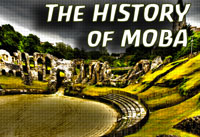The History Of MOBA Games
 The MOBA/Action RTS genre has appeared out of nowhere, going from a small mod to an industry staple over less than a decade. The last two or three years have seen entries in the genre massively increase, with both traditional takes on the series – the likes of Guardians of Middle-earth or League of Legends – and innovative use of the base rules – Awesomenauts and Monday Night Combat – proving that people want more and more of this addictive, twist-turned hit. The idea is simple: defend your area while attacking that of your enemy. Level your character, choose their skills and try to get the upper hand as quickly as possible because, if you don’t, you’re going to find yourself overwhelmed. This week we’re going to track the history of one of gaming’s most popular pastimes, and it starts even earlier than you’d think.
The MOBA/Action RTS genre has appeared out of nowhere, going from a small mod to an industry staple over less than a decade. The last two or three years have seen entries in the genre massively increase, with both traditional takes on the series – the likes of Guardians of Middle-earth or League of Legends – and innovative use of the base rules – Awesomenauts and Monday Night Combat – proving that people want more and more of this addictive, twist-turned hit. The idea is simple: defend your area while attacking that of your enemy. Level your character, choose their skills and try to get the upper hand as quickly as possible because, if you don’t, you’re going to find yourself overwhelmed. This week we’re going to track the history of one of gaming’s most popular pastimes, and it starts even earlier than you’d think.
Note: This is a special follow-up to our History of the MMO series –be sure to check it out.
Sacrifice
MOBA genre is generally considered to have begun with a mod for Warcraft II called Defence of the Ancients. Actually, there’s roots even further back, to a game called Sacrifice, released in 2000 and developed by Shiny Entertainment (who would later work on Enter the Matrix). Shiny had previously worked on the Earthworm Jim games, MDK, Wild 9 and possession-platformer Messiah, so they had experience in creating games that were not quite what people expected. Sacrifice was another example of this and was one of the first games that could be described as an Action RTS. Played in 3rd person mode, Sacrifice also managed to beat Lionhead’s Black and White to the use of mouse gestures in casting spells.

More important than all that though, it moved the focus of the RTS genre away from giant Command and Conquer-style battles, where controlling a whole army and creating new units was tantamount to the war effort. Instead, it was about controlling a single player, a small group of monsters. Looking at video on YouTube (or buying the Steam edition) shows a game that isn’t a million miles away from what would become known amongst certain groups as the DotA genre. Sacrifice marks one of the early examples of the RTS genre moving away from its roots and moving into something a little more combat-based. It was popular, it received fantastic reviews, but it didn’t kick-start a genre. For that to happen, it would take a mod, a lot of hard work, company battles and a little time.
Aeon of Strife
It’s impossible to think of the DotA genre without thinking of Blizzard. As we know, Warcraft III would later be home to the first instance of Defence of the Ancients, but you can’t write a history of this genre without a quick mention of Aeons of Strife, a mod map for StarCraft. The mod gave players a place to defend, an army of randomly generating units and powerful units to play as themselves. While the gameplay sounds the same, major parts of it are missing at this point – there’s no levelling, no items – and it was probably seen at the time as little more than a different way of playing StarCraft. It wasn’t considered a separate game and the following was dedicated but small.

Defence of the Ancients
In 2003, Blizzard released Warcraft III and the fans of Aeons of Strife started using the new and improved Blizzard map editor to create a better, more advanced, more balanced version of Aeons of Strife called Defence of the Ancients. Again, things moved slowly and the population playing the game stayed small. As the map editor was improved in expansions, the power of the modders controlling the game increased and it started to become a separate entity and increasingly more popular (think the sort of impact DayZ is having now). By 2005 and with contributions from various people, DotA had evolved into what we see today. But when a genre has been made by committee, by countless people making and improving and changing, who can really claim ownership on the whole thing?

League of Legends
DotA continued to grow over several mods – the most popular and largely considered the most important version of the original mod group being IceFrog’s DotA All-Stars - but it was still a mod and it still required Warcraft III to run. Blizzard have later revealed that piracy was one way that people got around that, and some have speculate that it’s part of the reason the company is a champion of the always-on style of DRM today. For others not willing to go down that route though, it required either a purchase of a game they may not have wanted to play or just sitting back and enjoying the games of others.
The mod was growing more quickly than anybody could have anticipated though, with an estimated 10 million players over its lifespan, and that would mean that other companies would like a slice of the pie. The first successful attempt at releasing a standalone version of the game came with 2009’s League of Legends. Available for free and complete with fresh, cartoon-style graphics, League of Legends took everything about the DotA mod and made it available to everybody. While DotA championed the genre, League of Legends made it mainstream and shook off the shackles of Blizzard’s original game. More than that though, it started the tradition of companies only gently building on pre-built ideas – League of Legends was almost identical to DotA and many games in the genre still rely on decisions made nearly 10 years ago.
Read our League of Legends review->
Valve vs. Blizzard
Blizzard is a key player in the history of MOBA Games, albeit a key player who stood at the side and didn’t want to be at all involved until people not paid to make games had proven themselves. They’d created the base games, they’d made the map editor, and they’d made the characters which had been edited for the original version of the mod. As far as a company owning Defence of the Ancients, the smart bet would have been on Blizzard. That’s why they were understandably upset when Valve announced they were going to be releasing a sequel, DotA 2. Although DotA 2 would involve IceFrog, Valve really didn’t have a claim on the DotA name or anything to do with the community, and a simple Google search shows that the community was split on whether this was a good thing or not. At the time, Blizzard dismissed Valve’s actions, saying that it “[didn’t] seem like the right thing to do.” At the beginning of this year, however, they sued Valve in order to sort out the issue once and for all.

After a few short months, Blizzard decided to back off. IN an example of “should have protected your copyrights,” Blizzard had to allow Valve the trademark, but was allowed to continue using DotA in a non-commercial sense (meaning that they could continue to interact with the DotA mod community). Blizzard renamed their attempt at a sequel to Blizzard All-Stars and Valve was allowed to continue developing DotA 2.
The Future
There’s a lot of history in MOBA Games genre, a lot of it very personal which I’ve had to leave out. The problem is, there’s no precedent for this sort of thing. Never before has something made by so many people become so massively popular, never before has it been handled in the way it’s been handled. As a result, we come to a gameplay style without an exact history, just as he-said-she-said from the community. One thing is certain, the MOBA genre is massive and it’s going to continue to grow. As it becomes more popular, will it lose its charm? Without any major improvements or even changes to the basic gameplay over the last 5 years, how long until we all become a bit tired of it?
I’s up to the companies making these games - and all eyes are on Valve, I believe – to show us what made the game special, to remind us as to why we still play it. For now though, harsh communities aside, it’s massively enjoyable and well worth your jaunt into the genre.







